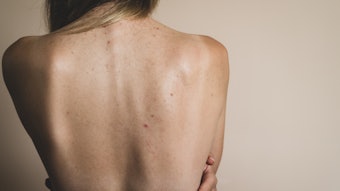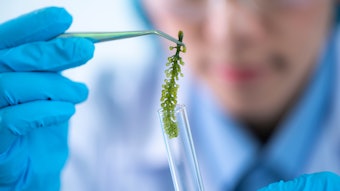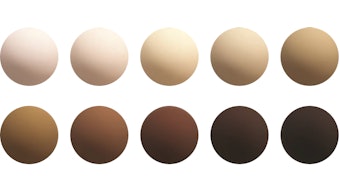Skin-warming massage compositions: Kosei Co. Ltd., Japan, describes skin-warming massage compositions containing glycerin, glycerin-modified silicones and heat-generating salts.1 The compositions consist of a first phase containing glycerin and a glycerin-modified silicone, and a second phase containing a cosmetically applicable salt that generates heat by dissolving in water, wherein the first and second phases are mixed before application. Either phase may further contain spherical powders. An example formula includes a first phase containing 50% glycerin, polyglycerin-modified silicone, fragrance, preservative, colorant and water; and a second phase containing calcium chloride, colorant and a preservative. The massage composition is said to spread smoothly on the skin and have excellent storage stability.
Log in to view the full article
Skin and Skin Care
Skin-warming massage compositions: Kosei Co. Ltd., Japan, describes skin-warming massage compositions containing glycerin, glycerin-modified silicones and heat-generating salts.1 The compositions consist of a first phase containing glycerin and a glycerin-modified silicone, and a second phase containing a cosmetically applicable salt that generates heat by dissolving in water, wherein the first and second phases are mixed before application. Either phase may further contain spherical powders. An example formula includes a first phase containing 50% glycerin, polyglycerin-modified silicone, fragrance, preservative, colorant and water; and a second phase containing calcium chloride, colorant and a preservative. The massage composition is said to spread smoothly on the skin and have excellent storage stability.
Ai-luros in skin care: Suemoto et al. discuss the useful functions of ai-luros in cosmetic applications.2 The authors examined a mixture of a water extract from the leaf and stem of Polygonum tinctorium louros (indigo) extract and 1,3-butylene glycol and found, at a 2.5% concentration of ai-luros, that the mixture exhibited a skin whitening effect by suppressing approximately 40% of melanin formation by B-16 melanoma cells. Ai-luros was not found to inhibit tyrosinase; however, treatment of B-16 melanoma cells with the material resulted in a reduction of tyrosinase protein in the cells. Furthermore, ai-luros suppressed the formation of prostaglandin E2 (PGE2) and nitric oxide (NO) by 0.78–6.25% in a mouse macrophage cell line. It also showed a 2,2-diphenyl-1-picrylhydrazyl (DPPH)-radical scavenging effect, superoxide dismutase (SOD)-like activity, and an elastase inhibitory effect. Thus, ai-luros could be useful in skin care for its skin-whitening, anti-inflammatory and antioxidant effects, and applicable in antiaging products.
Cosmetic efficacy after dermatologic treatment: Funasaka reviews the efficacy of cosmetics after cosmetic dermatologic treatment.3 Chemical peeling and nonablative laser (light) therapy have become widely accepted treatments. In order to obtain more desirable treatment results for skin conditions such as acne, pigmentation and wrinkles, the mechanisms of therapies such as peeling and laser therapy and their efficacy and limitations for the improvement of such skin conditions should be clarified.
In this review, the mechanisms and efficacy of such treatments were examined via in vitro and in vivo studies. The nonablative laser (light) therapy mechanism was found to possibly involve heat shock protein in the induction of skin rejuvenation.
Iron for collagen regeneration: Schubnel et al. describe an iron complex for collagen regeneration.4 Various molecules are capable of stimulating collagen synthesis, although vitamin C is used frequently; however, an iron-rich materiala could prove an effective alternative.
The product reportedly stimulates collagen synthesis and fills in wrinkles for a plumping effect; thus it is recommended for smoothing or renewing treatments.
UV-induced ROS: Hanson et al. review sunscreen enhancement of UV-induced reactive oxygen species (ROS) in the skin.5 The number of UV-induced (20 mJ/cm2) ROS generated in nucleated epidermis is dependent upon the length of time that the UV filter—octocrylene, octylmethoxycinnamate or benzophenone-3—remains on the skin surface.
Two-photon fluorescence images acquired immediately after application of 2 mg /cm2 to the skin surface, using formulations containing one absorber each, showed that the number of ROS produced was reduced dramatically and relative to the UV filter control. After each UV filter remained on the skin for 20 min, the number of ROS generated increased, although it remained below the number generated in the control. After 60 min, the filters generated ROS above the control. The data showed that when each of the three UV filters penetrated into the nucleated layers of the skin, the level of ROS increased above that produced naturally by epidermal chromophores under UV illumination.
Hair and Hair Care
t-Flavanone and hair growth: Moriwaki reviewed the effect of t-flavanone on hair growth.6
In 1998 the domestic market for hair growth agents in Japan was about 30 billion yen. The market’s growth spurt was set off by Taisho Pharmaceutical Co.’s launch of RiUP, a hair growth stimulant that hit the shelves in 1999; however, the market has been declining since its peak at 60 billion yen.
Recent market research estimates that more than 8 million men in Japan suffer some degree of hair loss, and industry sources estimate the size of the market will grow again because of the marketing of powerful products such as Merck’s Propecia, which was launched in December 2005 as the first oral medication for androgenic alopecia.
Accordingly, a great amount of R&D effort in cosmetic, pharmaceutical and bio-venture industries has centered on developing a hair growth agent with higher efficacy. The described paper outlines the mechanism of action of chief ingredients for hair growth agents on the market and explains the mechanism and efficacy of t-flavanone in detail.
Emulsion-type hair styling wax: LG Household and Health Care Ltd. discloses emulsion-type hair styling wax compositions with a less sticky feel for enhanced hair gloss.7 The composition comprises: 0.1–40.0% neopentyl glycol dicaprate; 0.1–10.0% water-soluble acrylate copolymer containing 50–95% of methacrylate monomer unit; 2–30% of carboxyl group-containing monomer unit; and 0.1–30.0% of polysiloxane group-containing monomer unit, based on the total weight of the water-soluble acrylate copolymer, wherein the water-soluble acrylate copolymer further comprises a UV absorption monomer unit.
The described composition is said to enhance hair gloss, hair spreading and hair fixing activity, yet with a less sticky feel upon the hair.
Oral Care
Improving periodontal tissue damage: Lion Corp. describes Lactoferrin, plant extracts and lecithin for improving periodontal tissue damage and a screening method thereof.8 The named materials are reported to improve periodontal tissue damage when screened by endotoxin of periodontal disease bacteria and gene expressions of related enzymes and proteins. Formulation examples of oral and dentifrice preparations are given.
Antiperspirants and Deodorants
Plant extracts in deodorants: Fuji Light Industrial Co. Ltd., Japan, describes deodorants combining plant extracts and cyclodextrin-inclusion compounds of other natural fragrant substances.9 The deodorants, useful for deodorizing indoor spaces, are manufactured by adjusting the pH level of plant extracts to 4.5–5.4 with organic acids and mixing the components with natural fragrant substances such as hiba-wood-oil-including cyclodextrins. These deodorants are reportedly effective for not only acidic or alkaline odors, but also neutral odors.
Regulation of microbial metabolism: Okumura et al. discuss the regulation of body odor by inhibition of microbial metabolism. Recent reports claim that 5alpha-androst-16-en-3-one (androstenone: ASN) is a key compound in body malodor and that female subjects are more sensitive than male subjects to ASN. Analysis of the suppressive effect of apricot kernel extract (AKE) was performed on ASN generated by microbial metabolism.10
In this study, investigators devised a cell-free system on ASN generation to investigate the suppression mechanism of AKE. ASN was generated by the microorganism Corynebacterium xerosis (C. xerosis) in the skin, and AKE was found to effectively suppress its generation. However, 5alpha androstan-3alpha-ol-17-one sulfate sodium salt (androsterone sulfate: ASRS) in C. xerosis was converted to ASN via 5alpha-androstan-3alpha-ol-17-one (androsterone: ASR) and AKE was not found to influence ASR generation through the system.
These results suggested that the effect of AKE on the regulation of ASN was based on the inhibitory action on the metabolic pathway leading to ASN from ASR in C. xerosis. In addition, the suppressive effect of AKE on ASN generation was compared to the effect of chemical bactericides under culture conditions in C. xerosis. AKE exhibited superior effects to those of bactericides in the same concentration. Furthermore, ASN continued to generate after sufficient treatment with the bactericide, isopropylmethylphenol, to markedly decrease the number of viable cells. These results show that the regulation of microbial metabolism, such as the effect of AKE, is important and could lead to the development of a novel deodorant system.
Sunscreens
Emollients for solubilizing organic UV absorbers: An anonymous author discloses emollient compositions containing one or more organic UV absorbers.11 Solubilization of the UV absorber is enhanced by certain emollients, which are further relevant due to their low viscosity, high diffusion and good spreading characteristics on the epidermis. The solubilizing agent employed may be a single component or a mixture of several lipophilic and hydrophilic solvents having a mixture ratio from 1:99 to 99:1, and most preferably from 20:80 to 80:20. The resulting UV-photoprotecting combination contains one or more UV absorbers.
The present cosmetic or pharmaceutical preparation contains 1–99%w/w, most preferably 5–80%w/w, of at least one solubilizing agent selected from lipophilic and hydrophilic solvents as described or mixtures thereof; and 0.05–40%w/w of at least one organic UV absorber and optionally a further UV absorber. Incorporating the present formulations could enable the preparation of leave-on sun care emulsions with the highest SPF and/or UVA protection factor possible, while using less sunscreen active.
Interesting Raw Materials
Papaya in personal care: Mikimoto Pharmaceutical Co. Ltd. and Sakamoto Yakusoen Y. K. disclose the use of Carica papaya (papaya) extracts for antioxidants, topical formulations, elastase inhibitors and Maillard reaction inhibitors.12 A papaya fruit ethyl alcohol extract used at 0.01% showed a 78.9% inhibition of elastase. The extract also reportedly showed Maillard reaction inhibitory activity and superoxide dismutase activity. Tablets, beverages and cosmetics containing papaya extracts showed skin lightening, elasticity-improving and antiwrinkle effects.
Sodium isostearyl 2-O-l-ascorbyl phosphate: Shibayama et al. describe the synthesis and characterization of a new ascorbic derivative: sodium isostearyl 2-O-l-ascorbyl phosphate.13 The novel alkyl ester derived from vitamin C (VC) originated in a stable ascorbate derivative—sodium l-ascorbic acid 2-phosphate (VCP-Na)—and was chemically synthesized. The thermal stability, surface tension, distribution between organic and water phase, and in vitro skin permeability were evaluated.
This monoalkyl ester derivative was identified as sodium isostearyl 2-O-l- ascorbyl phosphate (VCP-Is-Na) by UV spectra, IR spectra, mass spectra and NMR spectroscopy. The reaction afforded VCP-Is-Na in a high yield (60%). VCP-Is-Na exhibited satisfactory stability in neutral solution comparable to that of a typical stable derivative such as VCP-Na. Increased skin permeability was superior to VCP-Na and ascorbic acid (VC). VCP-Is-Na is susceptible to the enzymatic hydrolysis by tissue esterase and/or phosphatase released VC in the skin tissues. Thus, these characteristics indicate that the novel VC derivative presented here, VCP-Is-Na, may be effective pro-vitamin C for skin care applications.
Lysylthreonine and dipeptides: Sederma discloses the preparation of lysylthreonine and related dipeptides for cosmetic use.14 The invention described relates to the dipeptides Lys-Thr, Arg-Thr, and His-Thr and their N-acyl and other derivatives for use as cosmetics. These dipeptides, derivatives and analogs may be used alone or in an additive to produce cosmetics, topical pharmaceuticals and personal care products, particularly for skin care. Thus, N-palmitoyl-l-lysyl-l-threonine (Pal-KT) showed a significant increase in fibronectin synthesis at 1 ppm (+29%), 2 ppm (+32%), and 4 ppm (+34%). It was found to be more efficient than Pal-KTTKS at 2 and 4 ppm.
Improved hyaluronic acid derivatives: The Chisso Corporation describes hyaluronic acid derivatives with good water solubility, compatibility to hydrophobic substances and resistance to hyaluronidase and their manufacture.15 The hyaluronic acid derivatives bear ester groups formed from dicarboxylic acid anhydrides on their original hydroxyl groups, where their carboxyl groups can be neutralized to form salts with metal ions or other cations. The derivatives can be prepared in a nonaqueous solvent. Thus, mixing a solution of sodium hyaluronate in water with a dispersion of distearyldimethylammonium chloride in water at 45°C for 5 min gave a complex that was washed, dried and esterified with glutaric anhydride to yield a derivative with good water solubility.
Formulation
Polymeric surfactants and emulsion stabilization: Tadros reviews the principles of emulsion stabilization with special reference to polymeric surfactants.16 The main breakdown processes in emulsions are briefly described and a section is devoted to the structure of polymeric surfactants and their conformation at the interface.
Particular attention is given to two polymeric surfactants that are suitable for o/w and w/o emulsions. For o/w emulsions, a hydrophobically modified inulin (HMI), obtained by grafting several alkyl groups on the backbone of the inulin (polyfructose) chain, is the most suitable. For w/o emulsions, an A-B-A block copolymer of polyhydroxystearic acid (PHS), the A chains, and polyethylene oxide (PEO), the B chain, is the most suitable.
The conformation of both polymeric surfactants at the o/w and w/o interfaces is described. A section of this review also is devoted to the interaction between emulsion droplets containing adsorbed polymer surfactant molecules. This interaction is referred to as steric stabilization, and it is a combination of two main effects, namely: unfavorable mixing of the A chains, referred to as the mixing interaction, G mix; and loss of configurational entropy on significant overlap of the stabilizing chains, referred to as elastic interaction, gel. The criteria for effective steric stabilization are summarized.
O/W emulsions based on HMI are described, and their stability in water and in aqueous electrolyte solutions is investigated using optical microscopy. Very stable emulsions are shown to be produced both at room temperature and at 50°C. The reason for this high stability is described in terms of the multipoint anchoring of the polymeric surfactant by several alkyl groups, the strong hydration of the inulin (polyfructose) chains, and the high concentration of inulin in the adsorbed layer. W/O emulsions using PHS-PEO-PHS block copolymer can be prepared at a high volume fraction of water, and these emulsions remain fluid as well as stable for several months at room temperature and at 50°C.
The last two sections of the review are concerned with the problems of creaming or sedimentation and phase inversion. Creaming or sedimentation can be prevented by the use of thickeners in the continuous phase. These molecules produce non-Newtonian systems that will have a very high residual or zero shear viscosity. The latter, which may exceed 1000 Pas, can prevent any creaming or sedimentation. Syneresis of the emulsions can also be prevented by control of the bulk (or elastic) modulus of the system. Phase inversion in o/w emulsions can also be prevented using HMI, since this polymeric surfactant is not soluble in the oil phase. As long as coalescence and Ostwald ripening are prevented, the emulsions can be shown to remain stable for long times at room temperature and at 50°C.
Formulation technology progress: Sano reviews the recent progress of formulation technologies.17 Recent reports have investigated the structure of skin and conditions such as wrinkles. In order to formulate more efficient cosmetic products, developing new formulation techniques to enhance the efficacy of actives also is important. In this report, current formulation technologies were reviewed.
It is well-known that the intercellular lipid structure (lamellar-like structure), which is formed by intercellular lipids, plays an important role on barrier function and water-holding capability. The pseudo-sphingosine/pseudo-ceramide/water system formed a stable multilamellar emulsion, and this emulsion was found to be more effective than an emulsion containing the same amount of pseudo-ceramide in a crystal state.
Concentrated nanosize emulsions containing pseudo-ceramides were made utilizing a high-pressure homogenizer by optimizing the dynamic surface tension between a surfactant and interfacial tension. The diameter of the nanosize emulsion was about 30 nm with a narrow particle distribution. The moisturizing efficacy of a nanosized emulsion gave a relatively higher conductance value than that of a macro emulsion with the same composition.
Hydrogel patches are well-known for enhancing percutaneous absorption of hydrophilic active ingredients because of their occlusive effects. A hydrogel patch formulated with polar oils interacted with intercellular lipids, making it more likely to penetrate than conventional hydrogel patches containing nonpolar oil.
Frontier technologies: Mizutani Research Laboratories reviews frontier technologies in cosmetic science.18 Such technologies include: gene expression analysis of skin cells using DNA microarrays; differentiation studies using stem cells obtained from stratum corneum adipose tissue; structural analysis of the skin and hair using micro-beam X-ray diffraction; and study of human cell line activation test (h-CLAT) as an in vitro nonanimal alternative method for skin sensitization assay. These latest and most advanced technologies are expected to contribute to the research and development of the next generation of cosmetics.
References
1. JP 2006 306,843, Skin-warming massaging compositions containing glycerin, glycerin-modified silicones and heat-generating salts, Kosei Co. Ltd., Japan (Nov 9, 2006)
2. Y Suemoto et al, The useful functions of Ai-Luros in the cosmetic field, Frag J 34 9 79–82 (2006) (in Japanese)
3. Y Funasaka, The efficacy of cosmetics after cosmetic dermatologic treatment, Nippon Koshohin Gakkaishi 30 2 73–78 (2006) (in Japanese)
4. L Schubnel et al, An iron complex for collagen regeneration, SOFW 132 5 10–12 (2006) (in English)
5. KM Hanson et al, Sunscreen enhancement of UV-induced reactive oxygen species in the skin, Free Rad Biol & Med 41 8 1205–1212 (2006)
6. H Mizutani, Frontier technologies in cosmetic science, Frag J 34 9 53–57 (2006) (in Japanese)
7. KR 2006 26,368, Emulsion-type hair styling wax composition for conferring enhanced hair gloss and reduced sticky feeling, LG Household & Health Care Ltd., S. Korea (Mar 23, 2006)
8. JP 2006 298,913, Lactoferrin, plant extracts and lecithin for improving periodontal tissue damage and screening method thereof, Lion Corp., Japan (Nov 2, 2006)
9. JP 2006 296,807, Deodorants containing plant extracts and cyclodextrin inclusion compounds of natural fragrant substances, Fuji Light Industrial Co. Ltd., Japan (Nov 2, 2006)
10. T Okumura et al, Regulation of body odors by the inhibition of microbial metabolism: Analysis of the suppressive effect of apricot kernel extract on 5alpha-androst-16-en-3-one generated by microbial metabolism, Nippon Koshohin Gakkaishi 30 2 63–68 (2006) (in Japanese)
11. Anon (USA), Emollients used for solubilizing organic UV absorbers, IP.com Journal 6 3A 9 No. IPCO 000134094D (Feb 22, 2006) (in English)
12. JP 2006 298,812, Papaya (Carica papaya) extracts for antioxidants, topical formulations, elastase inhibitors and Maillard reaction inhibitors, Mikimoto Pharmaceutical Co., Ltd.; Sakamoto Yakusoen YK, Japan (Nov 2, 2006)
13. H Shibayama et al, Synthesis and characterization of new ascorbic derivative: Sodium isostearyl 2-O-l-ascorbyl phosphate, J of Oleo Sci 54 11 601–608 (2005) (in English)
14. WO 2006 114,657, Preparation of lysylthreonine and related dipeptides for cosmetic use, Sederma, France (Nov 2, 2006)
15. JP 2006 291,097, Hyaluronic acid derivatives with good water solubility, compatibility to hydrophobic substances and resistance to hyaluronidase and their manufacture, Chisso Corp., Japan (Oct 26, 2006)
16. T Tadros, Principles of emulsion stabilization with special reference to polymeric surfactants, J of Cosm Sci 57 2 153–169 (2006)
17. Sano, The recent progress of formulation technologies, Frag J 34 9 44–52 (2006) (in Japanese)
18. S Moriwaki, Effect of t-flavanone on hair growth, Nippon Koshohin Gakkaishi 30 1 23–28 (2006) (in Japanese)










